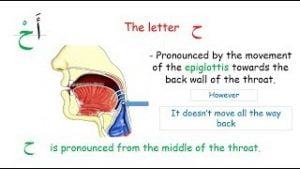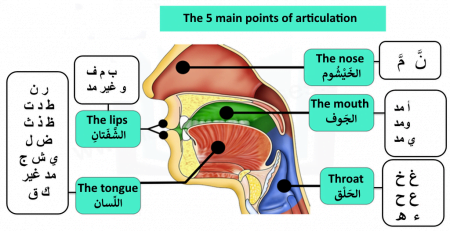Throat Letters (haroof e halqi) in Arabic
Common mistakes when pronouncing Arabic Throat Letters (haroof e halqi)
This article deals with some common mistakes related to articulation points of Throat Letters and more exactly, it is about common mistakes that happen while producing Throat Letters which mainly are occurred due to not producing the letter from its precise articulation point.
Here is a list of the common mistakes of Throat letters: Hamza, Haa, ‘Aeen, Haa, Ghayn, Khaw. We will start mentioning the letter and then its common pronunciation mistakes will follow in points:
Arabic Throat Letters (haroof e halqi) are ء ه ع خ غ خ
Letter 1: Hamza (ء)
- Applying Tafkheem (to be heavy) in the case of Tarqeek (to be light)
(Hamza) is a light throat letter, but it is a common mistake to make it heavy especially if Hamza is close to a heavy letter, this mistake in that throat letter may happen in a word like {أصابعهم}
- Applying Tasheel (not closing the articulation point of Hamza completely) in a case of Tahqiq (closing it completely), such as {يا أيها}
When pronouncing this throat letter, one should close the throat completely.
- Making Hamza sound too weak not to be heard. This mistake happens in case of stopping, such as {السماء }
Throat Letter 2: Haa (ه)
- Applying Tafkheem (to be heavy) in the case of Tarqeek (to be light)
(Haa) is a light throat letter, but it is a common mistake to make it heavy especially if it is close to a heavy letter, like {النهار}
- Pronouncing weak sound of the throat letter Haa.
Upon pronouncing the throat letter (Haa), one should not separate between the vocal cords more than required, this mistake may happen in a ward like {اهدنا}
- Do not pronounce the sound of the throat letter (Haa) clearly if it is close to another Haa or a sound very near to Haa like the throat letter (ح), such as {جباههم} and {وسبحه ليلا}.
- Pronouncing weak sound of throat letter Haa, or change its sound to the sound of Alif, in case stopping, like {الحاقة}
Throat Letter 3: ‘Aeen (ع)
- 1. Pronouncing the throat letter ‘Aeen (ع) from the articulation point of the heavy Alif, such as {نعبد}
The throat letter ‘Aeen should come from the middle of the throat,
- Cutting the sound of the throat letter ‘Aeen especially when it has sukoon, such as {يعملون}.
Tawasut (fair running of sound) should be applied to the throat letter ‘Aeen, for its articulation point is not so strong and not so weak.
- Applying Tafkheem (to be heavy) for the throat letter ‘Aeen, this mistake is common especially if it is close to a heavy letter, such as: {عصوا}.
- Pronouncing the throat letter ‘Aeen similar to the Hamza, such as {يعلم}
Ready to start Learning with an Expert Teacher? Get a free Trial now!
Browse Our Quran Courses:
- Quran Hifz Classes
- Quran Classes For Kids
- Tajweed Quran
- Quran Memorization Ijazah
- Quran Recitation Ijazah
- Basic Arabic Course for Beginners
- Norani Qaida
- Arabic Conversation Course
- Quran Stories for Kids
- Quran Tafseer for kids
Throat Letter 4: Haa (ح)
- Pronouncing the throat letter Haa (ح) like Khaa (خ) or Haa (هـ), such as {الرخمن الرخيم} or, like {الرهمن الرهيم}
This mistake is done basically by non-Arabs, for they are not used to using the articulation point of Haa (ح) which comes from the middle of the throat.
- Pronouncing the throat letter Haa (ح) without applying Hams (running of air) properly, such as {الرحمن الرحيم}.
Hams should be applied to the letter Haa.
- Pronouncing the throat letter Haa (ح) unclearly especially if it was close to ‘Aeen, {فاصفح عنهم}.
‘Aeen and Haa comes from the same articulation point, that is why the characteristic of Hams in Haa should be applied properly not to be skipped {فاصفح عنهم}
Throat Letter 5: Ghayn (غ)
- Mixing the sound of throat letter Ghayn with the sound of Qaaf (ق), such as {غير المغضوب}
Ghayn is pronounced from the nearest part of the throat, however, Qaaf comes from the back of the tongue. Some mix Ghayn with the sound of Qaaf,
- Applying Idgham for throat letter Ghayn into Qaaf, such as {لا تزغ قلوبنا}
That mistake happens with the reader does not apply the characteristic of Rakhawah (running of sound due to weakness of articulation point) for the letter Ghayn.
- Changing the throat letter Ghayn sound to the throat letter Khaa, such as {يخشى} and {يغشى}
That mistake happens because Ghayn and Khaw are produced from the same articulation point, but their characteristics are different: Ghayn has Hams (running of air), but Khaw has Jahr (stopping air).
- Applying Qalqalah for throat letter Ghayn, such as {المغضوب}
This happens when the Quran reader does not apply the characteristic of Rakhawah for Ghayn (running of sound).
- Applying stronger Tafkheen (to be heavy) in case Ghayn was with Kasrah, such as {من غِل}.
One should apply the lowest level of Tafkheem for the throat letter Ghayn in case it has Kasrah.
Throat Letter 5: Khaa (خ)
- Making the throat letter Khaa light, such as {خالدين}.
Khaw is a heavy throat letter, so heaviness shall be applied for it,
- Applying strong Tafkheen (to be heavy) in case of Khaw with Kasrah, such as {وخِيفة}
One should apply one of the lowest levels of Tafkheem for the throat letter Khaw in case it has Kasrah.
check our blog about Makhraj of all Arabic letters
Conclusion of Arabic throat letters
Some sounds of Arabic throat letters are special for the Arabic language. Mistakes may occur due to changing the proper articulation points of the throat letter or do not apply its correct characteristics. Practical recitation of the Quran in front of well-trained teachers is always required.













